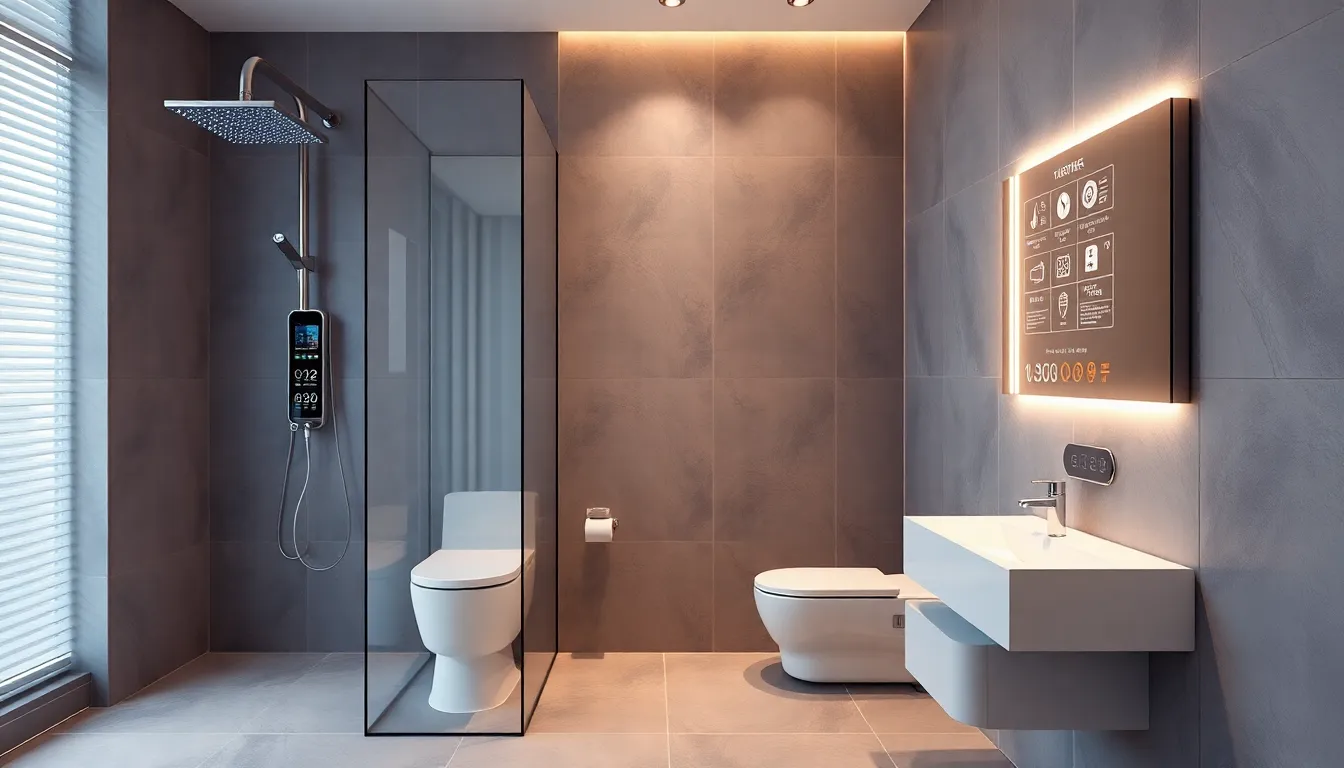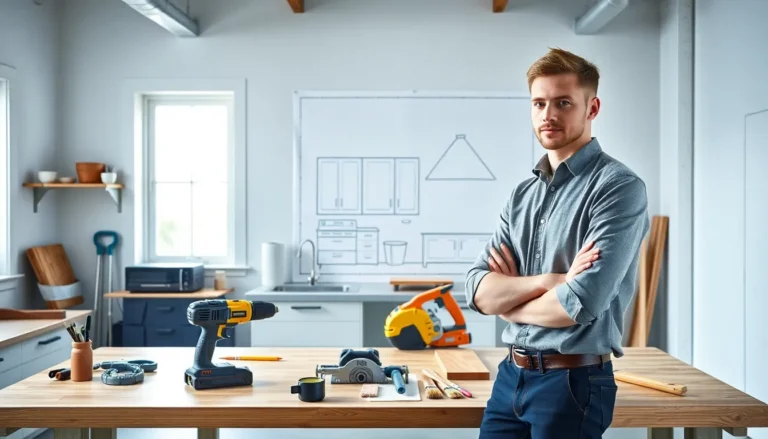Table of Contents
ToggleImagine stepping into your bathroom and having it greet you like an old friend. Smart bathroom technology is here to transform that mundane space into a high-tech haven. Gone are the days of struggling with leaky faucets and stubborn toilet seats. Now, you can control everything from the shower temperature to the ambient lighting with just a tap on your smartphone.
Overview Of Smart Bathroom Technology
Smart bathroom technology revolutionizes everyday routines by integrating automation and connectivity into bathroom features. Users can adjust water temperature with smart shower systems, ensuring comfort and energy efficiency. Intelligent toilets feature automatic seats and built-in bidets, enhancing hygiene and convenience.
Innovative mirrors with built-in displays provide real-time information, such as weather updates and news. Smart lighting and sound systems allow for personalized ambiance tailored to the user’s mood. Voice-controlled assistants enable hands-free operation, making it easier to manage various tasks.
Sensors play a crucial role in smart bathrooms, detecting occupancy and adjusting lighting and water usage accordingly. For example, smart faucets activate with motion sensors, minimizing water waste. Moreover, these technologies prioritize safety, offering features like slip-resistant surfaces and automated lighting.
Mobile apps complement these technologies, giving users remote control over their bathroom features. Data analytics from these applications enhance user experiences, offering insights on water consumption and suggesting actions for improved sustainability. This dashboard-like approach empowers users to make informed decisions about their bathroom usage.
Overall, smart bathroom technology combines functionality, efficiency, and comfort, transforming traditional spaces into modern retreats. Enhanced experiences drive the trend toward smarter solutions, making it appealing for homeowners seeking innovation in their daily lives.
Key Features Of Smart Bathrooms

Smart bathrooms incorporate advanced technologies that elevate convenience and efficiency. These innovations bring together functionality and modern design, making daily routines more enjoyable.
Smart Showers
Smart showers provide adjustable water temperatures through smartphone controls. Users can set personalized preferences for different family members and save these settings for quick access. Features like water flow monitoring enhance energy savings while ensuring comfortable use. Additionally, voice-activated controls allow for hands-free operation, simplifying the shower experience.
Smart Toilets
Smart toilets enhance hygiene and comfort, offering automatic seats and integrated bidets. Users experience features such as heated seats and deodorizing technology that improve overall cleanliness. Advanced models also include self-cleaning functions and water conservation settings, significantly reducing water usage. Remote control options can provide an added layer of convenience.
Smart Mirrors
Smart mirrors come equipped with built-in displays providing real-time information. Users can access news updates, weather forecasts, and digital calendars while preparing for the day. Some models also feature touchless controls for lighting adjustments and integrated speakers for music playback. Enhanced anti-fog technology ensures a clear reflection during and after showers.
Smart Lighting
Smart lighting systems allow users to customize brightness and color settings, creating a perfect atmosphere for any occasion. Motion sensors automatically activate lights when someone enters the bathroom, promoting safety and convenience. Integration with smart home systems lets users schedule lighting routines based on daily habits. Energy-efficient LED options contribute to overall sustainability while providing ample illumination.
Benefits Of Smart Bathroom Technology
Smart bathroom technology offers numerous advantages that enhance daily routines and promote a more enjoyable environment. From increased convenience to improved hygiene, this technology transforms mundane tasks into seamless experiences.
Increased Convenience
Smart technology simplifies daily activities in the bathroom. Users can utilize voice commands to control features like lighting and temperature. Automated functions, such as self-cleaning toilets and motion-activated faucets, eliminate the need for manual operation. Furthermore, smart mirrors provide quick access to news and updates, enriching morning routines. Mobile apps allow for remote adjustments, ensuring the bathroom is always ready for use. Personalization options let individuals customize their experiences, catering to preferences.
Improved Hygiene
Maintaining hygiene is crucial in bathrooms, and smart technology enhances this aspect significantly. Intelligent toilets with bidets offer thorough cleaning without the use of toilet paper, promoting better cleanliness. Automatic flush systems decrease cross-contamination risks by eliminating the need for physical contact. Smart faucets with touchless sensors reduce germ spread, making handwashing more sanitary. Additionally, automated cleaning features in toilets and sinks ensure surfaces remain pristine, contributing to overall bathroom cleanliness. These advancements encourage healthier habits and improve users’ overall experience.
Energy Efficiency
Smart bathroom technology also plays a vital role in conserving resources. Water-saving fixtures, such as smart showers and faucets, regulate flow to minimize waste. Users can monitor water consumption through mobile apps, gaining insight into their usage patterns. Intelligent lighting systems utilize energy-efficient LED bulbs and adaptive settings to reduce electricity waste. Automated features, like motion sensors, ensure lights turn off when the bathroom is unoccupied. These advancements lead to significant energy savings and promote environmentally friendly practices while enhancing the bathroom experience.
Challenges And Considerations
Smart bathroom technology introduces various challenges. Users must consider specific factors before making an upgrade.
Cost Factors
Initial expenses can be substantial when installing smart bathroom technology. Brands offer a range of prices for devices, leading to potential budgeting challenges. Smart toilets and automated faucets may cost between $500 to $1,500. Installation fees add to the overall investment, typically ranging from $100 to $300. While energy savings from enhanced efficiency might offset costs, upfront financial commitment poses a barrier for many homeowners. Sticking to a budget becomes essential, especially for comprehensive renovations.
Integration With Existing Systems
Adapting smart technology to current setups proves complex. Compatibility issues may arise with older plumbing or electrical systems. Some devices require specific wiring or plumbing for proper integration. Homeowners might need additional adapters or services, increasing time and expense. Ensuring that new systems communicate effectively with existing features often necessitates professional assistance. Seamless integration enhances user experience, but understanding these technological limitations remains crucial.
Future Trends In Smart Bathroom Technology
Innovations continue to evolve within smart bathroom technology, shaping the future of home design. Advanced integration of artificial intelligence promises to further personalize user experiences, enabling devices to learn preferences over time. Smart faucets might incorporate touchless controls with enhanced sensors, improving hygiene and reducing water consumption simultaneously.
Mobile app functionality is likely to expand, providing real-time analytics on water usage and offering tailored suggestions for conservation. Smart mirrors could evolve to include virtual wellness screenings, analyzing skin conditions or health metrics using integrated cameras and AI algorithms. Voice-activated features are set to enhance convenience, allowing users to control multiple devices without manual interaction.
Sustainability remains a key focus, with manufacturers expected to emphasize eco-friendly materials in smart fixtures. Water-saving technologies might become standard in smart toilets and showers, contributing significantly to resource conservation. Automated cleaning systems could gain popularity, utilizing UV light or advanced disinfectants to maintain hygiene effortlessly.
In addition, seamless connectivity across smart home ecosystems will characterize future smart bathrooms. Interoperability among various devices enhances functionality and simplifies user interaction. Sensors could become more sophisticated, detecting not just occupancy but also preferences for temperature or brightness based on individual user habits.
Health and safety innovations are likely to drive product development, with emphasis on slip-resistant surfaces and adjustable lighting that caters to different user needs. Overall, the ongoing advancements in smart bathroom technology promise to redefine comfort, sustainability, and accessibility, ensuring that modern bathrooms exceed current expectations.
Smart bathroom technology is transforming how people experience their daily routines. With a focus on convenience and efficiency it brings a new level of comfort to a traditionally overlooked space. As homeowners embrace these innovations they can expect enhanced hygiene and personalized environments that cater to their unique preferences.
While the initial investment may seem daunting the long-term benefits in energy savings and improved lifestyle can outweigh the costs. As technology continues to evolve future smart bathrooms will likely integrate even more advanced features promoting sustainability and health.
Incorporating smart technology into bathrooms not only elevates functionality but also creates a modern oasis that aligns with contemporary living. Embracing this trend means stepping into a future where comfort and innovation go hand in hand.







